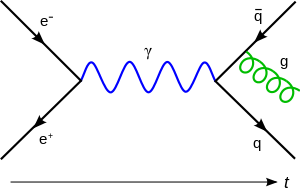Faddeev–Popov ghost
In physics, Faddeev–Popov ghosts (also called Faddeev–Popov gauge ghosts or Faddeev–Popov ghost fields) are extraneous fields which are introduced into gauge quantum field theories to maintain the consistency of the path integral formulation. They are named after Ludvig Faddeev and Victor Popov.[1][2]
| Quantum field theory |
|---|
 |
| History |
|
Background
|
|
|
Scientists
|
A more general meaning of the word ghost in theoretical physics is discussed in Ghost (physics).
Overcounting in Feynman path integrals
The necessity for Faddeev–Popov ghosts follows from the requirement that quantum field theories yield unambiguous, non-singular solutions. This is not possible in the path integral formulation when a gauge symmetry is present since there is no procedure for selecting among physically equivalent solutions related by gauge transformation. The path integrals overcount field configurations corresponding to the same physical state; the measure of the path integrals contains a factor which does not allow obtaining various results directly from the action.
Faddeev–Popov procedure
It is possible, however, to modify the action, such that methods such as Feynman diagrams will be applicable by adding ghost fields which break the gauge symmetry. The ghost fields do not correspond to any real particles in external states: they appear as virtual particles in Feynman diagrams – or as the absence of gauge configurations. However, they are a necessary computational tool to preserve unitarity.
The exact form or formulation of ghosts is dependent on the particular gauge chosen, although the same physical results must be obtained with all gauges since the gauge one chooses to carry out calculations is an arbitrary choice. The Feynman–'t Hooft gauge is usually the simplest gauge for this purpose, and is assumed for the rest of this article.
Spin–statistics relation violated
The Faddeev–Popov ghosts violate the spin–statistics relation, which is another reason why they are often regarded as "non-physical" particles.
For example, in Yang–Mills theories (such as quantum chromodynamics) the ghosts are complex scalar fields (spin 0), but they anti-commute (like fermions).
In general, anti-commuting ghosts are associated with bosonic symmetries, while commuting ghosts are associated with fermionic symmetries.
Gauge fields and associated ghost fields
Every gauge field has an associated ghost, and where the gauge field acquires a mass via the Higgs mechanism, the associated ghost field acquires the same mass (in the Feynman–'t Hooft gauge only, not true for other gauges).
Appearance in Feynman diagrams
In Feynman diagrams the ghosts appear as closed loops wholly composed of 3-vertices, attached to the rest of the diagram via a gauge particle at each 3-vertex. Their contribution to the S-matrix is exactly cancelled (in the Feynman–'t Hooft gauge) by a contribution from a similar loop of gauge particles with only 3-vertex couplings or gauge attachments to the rest of the diagram.[lower-alpha 1] (A loop of gauge particles not wholly composed of 3-vertex couplings is not cancelled by ghosts.) The opposite sign of the contribution of the ghost and gauge loops is due to them having opposite fermionic/bosonic natures. (Closed fermion loops have an extra −1 associated with them; bosonic loops don't.)
Ghost field Lagrangian
The Lagrangian for the ghost fields in Yang–Mills theories (where is an index in the adjoint representation of the gauge group) is given by
The first term is a kinetic term like for regular complex scalar fields, and the second term describes the interaction with the gauge fields as well as the Higgs field. Note that in abelian gauge theories (such as quantum electrodynamics) the ghosts do not have any effect since and, consequently, the ghost particles do not interact with the gauge fields.
Footnotes
- Feynman discovered empirically that "boxing" and simply dismissing these diagrams restored unitarity. "Because, unfortunately, I also discovered in the process that the trouble is present in the Yang−Mills theory; and, secondly, I have incidentally discovered a tree−ring connection which is of very great interest and importance in the meson theories and so on. And so I'm stuck to have to continue this investigation, and of course you appreciate that this is the secret reason for doing any work, no matter how absurd and irrational and academic it looks: we all realize that no matter how small a thing is, if it has physical interest and is thought about carefully enough, you're bound to think of something that's good for something else."[3]
References
- Faddeev, L. D.; Popov, V. (1967). "Feynman diagrams for the Yang-Mills field". Phys. Lett. B. 25 (1): 29. Bibcode:1967PhLB...25...29F. doi:10.1016/0370-2693(67)90067-6.
- Chen, W.F. (2008). "Quantum field theory and differential geometry". Int. J. Geom. Methods Mod. Phys. 10 (4): 1350003. arXiv:0803.1340v2. doi:10.1142/S0219887813500035.
- Feynman, R.P. (1963). "Quantum Theory of Gravitation". Acta Physica Polonica. 24: 697−722.
External links
- Faddeev, Ludwig Dmitrievich (2009). "Faddeev-Popov ghosts". Scholarpedia. 4 (4): 7389. Bibcode:2009SchpJ...4.7389F. doi:10.4249/scholarpedia.7389.